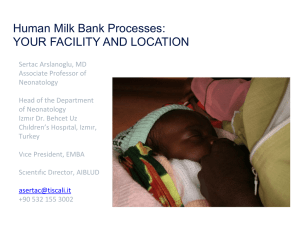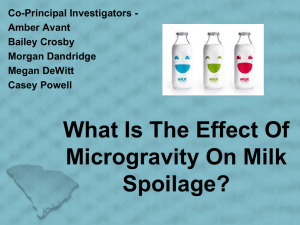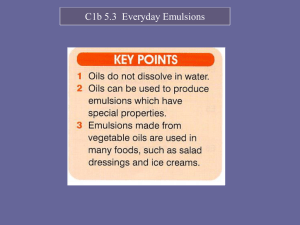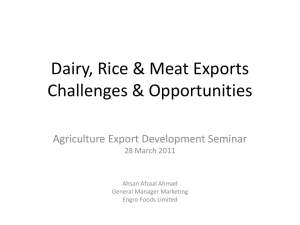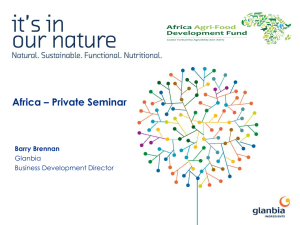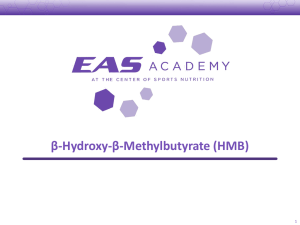Donor Milk Banking in South Africa
advertisement
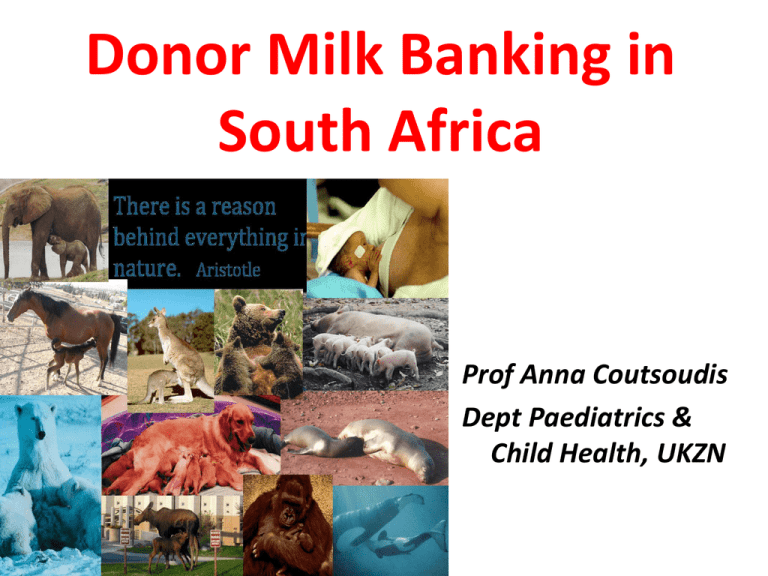
Donor Milk Banking in South Africa Prof Anna Coutsoudis Dept Paediatrics & Child Health, UKZN What is Human Milk Banking (HMB)? A system that - collects, screens, pasteurises and dispenses human milk donated by breastfeeding mothers for infants who for a variety of reasons do not have access to their own mother’s milk. It gives the message that breastmilk is so important for infants that when it is not available we put systems in place to access this valuable commodity. Why Donor Milk for vulnerable infants? • Mother’s own milk is best option for babies • Where this is not possible the FIRST alternative according to WHO and UNICEF is the use of donor human milk for: – Orphaned infants – Low birth weight infants – who do not have access to mother’s own breastmilk – These infants are particularly vulnerable to necrotising enterocolitis if fed on formula milk, therefore donor milk is vital for them where mother’s own milk is not available Many developed countries responded to this need by opening donor breastmilk banks However Brazil has led the world in the breastmilk banking ……… The Brazilian National Network of HMB • The largest HMB system in the world – 200 banks supplying milk to 170,000 infants (per year) • Supported by Ministry of Health – Integral part of the strategy of promoting breastfeeding – Government-led social marketing campaigns and education in schools/health centers helped to raise the visibility of human milk banking – Attributed donor breastmilk to lowering of Brazil’s IMR by >50% between 1980-2009 – Saved approximately $540 million in one year The Brazilian National Network of HMB Systems in place - Convenient drop-off stations - Fire fighters/policemen collect milk from donors weekly - Commercial –grade machines that automate the Holder pasteurization method - Milk is tested for fat, acidity, protein, calcium Procedures are supervised from municipality/state levels History of Milk Banks in South Africa • HMB once existed informally in neonatal units – Donated breast milk – Wet-nursing • 1980s HMBs stopped as HIV discovered in breastmilk • Later heat treatment was proven to render milk safe, while preserving most of its immune properties thus milk banks started operating again in US and UK • In 2000 the first community based HMB was started in Durban, KwaZulu-Natal specifically to provide breastmilk for AIDS orphans First Community Based Breastmilk BankiThemba Lethu Baby A • Was born prematurely weighing 1500g • Abandoned in hospital. He was brought to the home at 7 months of age weighing 2700g. In 7 months of being fed on formula he put on 1200g! • In 2 weeks of being fed on donated breastmilk he put on 550g The success of this bank resulted in many other banks being set up in South Africa • Established HMB –24+ banks in seven provinces • (GP, KZN, WC, FS, EC, MP and NC) • Recipient facilities –10+ (public and private -majority in Gauteng) • Drop off corners –Approx. 4, mainly in KZN Apart from the community HMB all other HMBs are attached to neonatal intensive care units 1. The public model – public hospital staff run the milk bank but operations funded by donations/grants • Several hospitals in W Cape serviced by Milk Matters • Kalafong Hospital & King Edward Hospital 2. The public-private partnership model • South African Breast milk Reserve (SABR) The Public Hospital Model • HMB is situated within neonatal unit • Pasteurization of milk by: – Commercial pasteuriser – One hospital Kind Edward Hospital in Durban uses low-technology pasteurization system – flash-heating Jar of milk is flash heated - once the water is rapidly boiling. the jar of milk is removed • Donors – Donors are recruited within the hospital, screened for lifestyle risks, and screened for HIV – Dedicated area for mothers to express milk –where possible, mothers are matched: preterm milk given to preterm babies • Recipients are infants who – Do not have access to mother’s breastmilk – weigh < 1500 grams – HIV exposed infants prioritized – Provided by prescription from a doctor • Up to 14 days • Depending on availability of milk and the infant’s health The Public-Private partnership modelrun by SABR • Donor milk is processed and stored at a central point usually in the private hospital (fees levied) – supply milk to > 40 Hospitals • Recipients in private hospital - are asked to donate money to support operations of the HMBprocessing and transporting charges • Recipients in Public hospitals -receive donor milk for free/or minimal administrative fee Human Milk Banking Association of South Africa (HMBASA) www.hmbasa.org.za • Non-profit organization whose objectives are to coordinate, advise, and monitor HMBs to ensure adherence to their guidelines. • Board of HMBASA consists of wide spectrum of professionals (eg obstetricians, neonatologists, microbiologist, lactation consultants) • Database of milk banks in SA isnavailable on website Underlying principles: • HMBs should go hand in hand with the promotion, protection and support of breastfeeding. • Milk banks should operate on a non- profit basis Increasing Acceptability of Donor Breast Milk What are the concerns about donor milk? 2009 acceptability study using focus group discussions in Durban, KZN: • Fear – Possible transmission of HIV and other diseases – Stored breast milk-even if refrigerated-unsafe after several hours • Lack of awareness on procedures for – Screening of donors for infectious diseases – Cold storage – Pasteurization to render breastmilk safe • Cultural issues – – – – Sense of discomfort with donated milk Religious prohibitions against sharing breast milk/ bodily fluids. infants may take on the genetic traits of the milk donor. Donor’s race was not a significant issue. What were main concerns about donor milk? Discussants felt that hygiene and safety were much more important than factors related to race and ethnicity in determining acceptability. A lack of familiarity with the processing of donor breast milk—including donor screening, pasteurization, and cold storage—is the largest impediment to greater acceptability. This can be readily remedied, however, through education. How can acceptability issues be overcome? • Knowledge about processes and standards can address lingering concerns • the more women donate, the more infants will benefit, and the more acceptable the practice will become. Ensuring safety and quality of Donor Breast Milk Screening of Donors to reduce risks • Good health and no high-risk lifestyle behaviours • Tested for HIV, syphilis, hepatitis B, infectious diseases. • If donating for > 3 months, HIV test is repeated. • No piercings, tattooing, traditional scarification and blood transfusion in past 12 months . • Non-smokers/drugs • No hard liquor • No intake of medications which are contra-indicated while breastfeeding. Ensuring safe handling in donors’ homes • Donors must follow rigorous safety measures for handling and storing breast milk at home. • Training on hygiene and expressing breast milk • Use of glass jars or hard plastic containers supplied and donor number given • Donors must have working freezers for immediately freezing milk after it is expressed • Frozen milk must be transported in secure cool boxes packed with ice packs. Processing and pasteurization •Donor breast milk must be kept frozen until pasteurized (as soon as possible after collection) •Processed under hygienic conditionshand-washing/sterile gloves. •Pasteurization •Holder method-commercial-grade pasteurizer -62.5 C/ 30 min •Flash-heating- higher temperature (72 C) for shorter time (heating milk-filled glass jar in a bath of boiling water). Safe-guarding Quality at the Milk Bank • Post-pasteurization procedures –Sterile technique is maintained throughout processing –Confidential records are kept for 5 years –Donor breast milk samples are labelled with • donor number and date of collection • pasteurization batch number and date. Safe-guarding Quality at the Milk Bank Post-pasteurization procedures •samples are tested regularly for bacterial contamination •Donor pasteurized milk stored at –18°C for up to 6 months •Pre-term infants, breast milk stored for only 3 months. Safe-guarding Quality at the Milk Bank Trained staff for optimal results HMB are managed by trained personnel-medical director, neonatologists, lactation consultants, and microbiologists On-going training should cover SOPs, checking of equipment etc. Saving lives and Resources wider use of donor milk to vulnerable infants promises to cut costs while reducing lifethreatening complications Saving lives and Resources Feeding breast milk to lbw infants lowers the incidence of: • Septicemia • Necrotizing enterocolitis (NEC) • Neurological impairment • malabsorption Saving lives and Resources US study – calculated that for each $1 spent on donor milk to prevent NEC they would save $37 in hospital costs for treating NEC Wight N, J Perinatology 2001 • What would the cost-savings be in South Africa if HMB was integrated into the health care system? – To date, this has not been fully investigated. Comprehensive cost-effectiveness studies of HMB are needed to fully demonstrate the potential benefits of this strategy. Conclusion • HMBs in South Africa are successful but limited access. • Expanding HMB could benefit vulnerable infants and improve child survival • HMB could be integrated into national breastfeeding promotion strategies. • Knowledge about processes and standards may address lingering concerns • Quality assurance standards must be maintained while scaling up availability of HMBs. Conclusion Dept of Health leadership and support are vital to ensure HMBs are given credibility amongst the community. This will allow scale up and regulation of milk banking to ensure safety and adherence to guidelines of human milk banking. Rough estimate that money (204 million) spent on formula in the PMTCT programme could fund many thousand breastfeeding counsellors who can also be used to oversee donor breastmilk banking activities in neonatal units (as an integrated breastfeeding promotion strategy).

